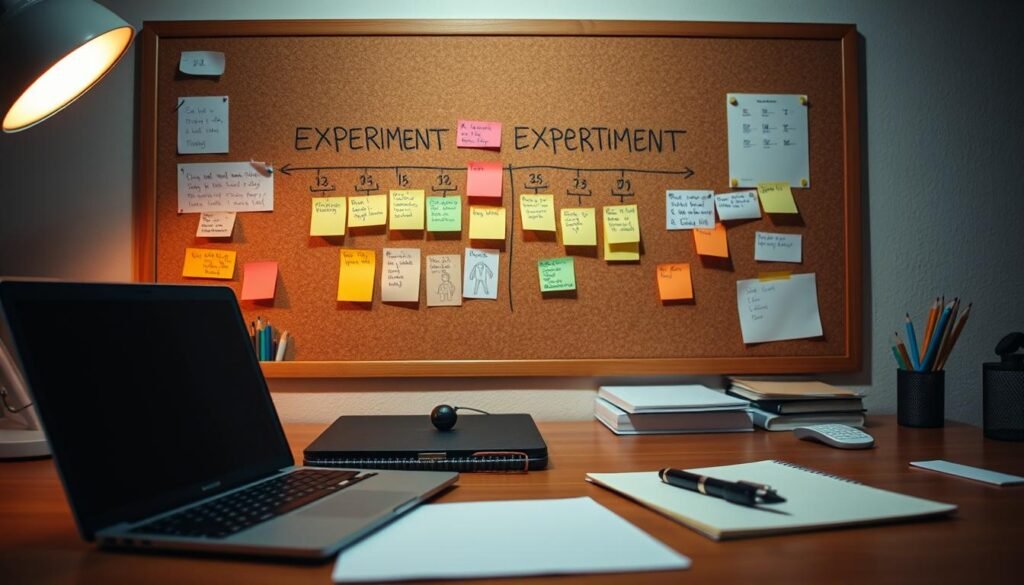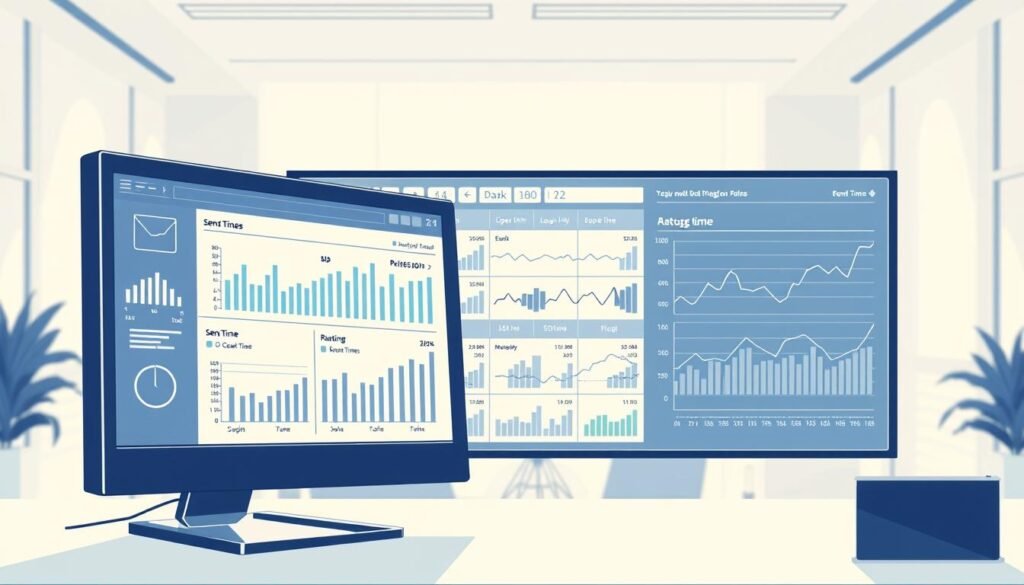You want higher open rates and clearer results. This introduction explains how Perfect Timing and Time Travel change when your email hits an inbox, so you can plan a smarter campaign.
Perfect Timing delays delivery up to 23 hours to match each contact’s best hour for opens and clicks. If someone signs up on their own, the system can use their sign-up hour; imported contacts receive the newsletter at the scheduled hour and do not get the delay.
We’ll map core concepts, show an example of staggered delivery, and explain why you should wait 48–96 hours before judging rates. You’ll learn how to set a control, pick variants, and segment your list so you can attribute gains cleanly.
Key Takeaways
- Perfect Timing aligns emails with individual behavior to lift open rates.
- Time Travel preserves the same local clock hour across regions.
- Imported contacts follow scheduled delivery; organic sign-ups can use sign-up hour.
- Wait 48–96 hours to assess performance because sends are staggered.
- Run clear control/variant tests and segment lists for accurate results.
Why Send Time Still Matters in 2025 for Email Marketing Performance
Even in 2025, when inboxes brim with messages, the hour you pick still shapes who opens your emails. In crowded channels, simple timing choices move open rates and downstream conversions more than many realize.
2024 benchmarks show why: automated and triggered messages hit 45.38% and 51.05% open rates with roughly 5% CTR. Regular newsletters averaged 40.08% opens and 3.84% CTR. Those gaps prove that meeting customers when intent is high lifts marketing performance.
Mobile habits matter. About three quarters of U.S. consumers buy on smartphones, and people skim emails across the day. Aligning timing to morning routines or midday breaks improves engagement and reduces message fatigue.
Practical takeaway: treat timing as a core lever next to content and audience. Small open rate gains compound across large lists and frequent campaigns. For a tactical next step, review A/B resources like A/B testing subject line examples to pair better timing with stronger creative.
send time optimization experiments getresponse: What You’ll Learn and Achieve
Learn the concrete goals and business outcomes you can prove by aligning messages with people’s peak engagement windows.
Goals: You’ll target higher open rates, stronger click-through rates, and better engagement rates across campaigns. The test design uses prior behavior so emails hit the most receptive part of the day for each customer.
Benchmarks matter. For example, Time Travel shows open rates near 30.21% and CTR around 4.41% versus average campaign rates of 26.80% and 1.89%. Those differences show measurable results when delivery matches user habits.
- You’ll design a test that proves higher open rates by delivering each email during the individual’s best day-part.
- Measure click-through rates and click-to-open to confirm timing converts attention into action.
- Reduce fatigue and lift brand trust by avoiding low-intent interruptions and respecting customers’ routines.
- Include data checks, content controls, and segment analysis (new vs active customers) so outcomes can be attributed to timing, not creative changes.
Outcomes: Expect fewer unsubscribes, rising engagement, and stronger long-term revenue as emails feel more relevant and considerate to people’s schedules.
Understanding GetResponse Tools: Perfect Timing vs. Time Travel
Choose the delivery method that matches your campaign goals and audience geography. These two tools change whether emails prioritize each subscriber’s peak hour or preserve a single local hour across regions.
Perfect Timing
Perfect Timing uses historical data to predict each contact’s best hour and delays delivery up to 23 hours to hit that window. If a person signed up organically with no prior activity, the system uses their sign-up hour. Imported contacts follow the scheduled hour and do not get the delay.
Time Travel
Time Travel delivers at the same local clock hour for every recipient. For global newsletters and launches, this ensures fairness: recipients in different zones receive messages at the same local hour, such as 10 a.m. in each market.
When to choose which
- Perfect Timing for behavior-driven campaigns where data suggests varied engagement windows and you want higher open rate per contact.
- Time Travel for global announcements and date-sensitive newsletters that must land at a consistent local hour.
- Example: John (9–10 a.m.) gets the email immediately; Mike (2–3 p.m.) is delayed 5 hours; Sue (7–8 p.m.) is delayed 10 hours.
- Mix both: use Time Travel for launches and Perfect Timing for nurture and promotions. Document your choice in the campaign brief so stakeholders understand expected delivery patterns and rates.
Designing Your First Experiment the Right Way

Design a clean, measurable test so timing is the only variable between groups. Start with a short, testable hypothesis and lock content so creative differences do not affect results.
Hypothesis and control vs variant
Example hypothesis: “Using Perfect Timing will improve open rate vs a fixed 10 a.m. control over seven days.”
Define the control as a fixed day and hour. Define the variant as the behavior-driven delivery. This way any change in open or click rates maps to timing alone.
Audience, sample size, and duration
Segment the list into new subscribers, imported contact records, active openers/clickers, and dormant users. Note: imported contacts won’t get Perfect Timing on that send; new sign-ups without history default to their sign-up time.
- Ensure sample size is large enough to detect differences; small lists need longer runs.
- Run across multiple days to control for day-of-week and seasonality effects.
- Wait 48–96 hours after the campaign to evaluate because deliveries can span nearly a full day.
Decision rule: adopt the variant if open rate improves ≥10% with stable unsubscribe and complaint metrics. Track clicks and conversions too, not just opens, to confirm true engagement.
Step-by-Step: Implementing Perfect Timing in GetResponse
Enable Perfect Timing in a few clicks so your emails arrive when each subscriber is most likely to open. This section walks you through the exact steps and special cases to plan a clean campaign.
Navigating Tools › Email Marketing and Create newsletter
Go to Tools > Email Marketing, then click Create newsletter. Scroll to the delivery options and toggle Perfect Timing for the campaign.
Enabling Perfect Timing and scheduling guidelines
Set your base schedule with the awareness that Perfect Timing can delay delivery up to 23 hours to match each contact’s peak hour.
Document your evaluation window—plan to analyze results after 48–96 hours so delayed deliveries aggregate correctly.
Special cases: sign-up hour for new contacts and imported lists
New subscribers without prior behavior will receive the email at their sign-up hour the first time. Imported contact records, however, will receive the newsletter at the scheduled hour even when the toggle is on.
- Use consistent subject, preheader, and content so changes in open rates map to timing, not creative differences.
- If you need same-day visibility, schedule early enough to allow the 23-hour window.
- Tag campaign names and variants to simplify later analysis and reporting.
After launch: monitor deliverability and basic metrics, but reserve final judgment until your defined analysis window closes.
Step-by-Step: Implementing Time Travel for Global Lists
Use Time Travel to deliver the same local clock hour worldwide. This creates a synchronized experience so recipients in Miami, London, and Hong Kong all see your message at, for example, 10 a.m. local. In 2023 benchmarks, Time Travel hit a 30.21% open rate and 4.41% CTR versus 26.80% and 1.89% for standard sends.
Picking the “send email” time and ensuring consistent local delivery
Choose a universal local hour (commonly 9–11 a.m.) so each market receives the campaign at the same clock moment. That removes manual zone splits and simplifies QA.
- Pick one local hour that aligns with your buyers’ routines.
- Benchmark against past fixed-hour emails to measure uplift.
- Document regional holidays and workweek differences to avoid clashes.
Coordinating with other channels and website promotions
Align banners, social posts, and paid ads so the offer is live when emails arrive per region. Coordinate with customer service to staff for spikes after the drop.
- Use Time Travel for launches, webinars, and timed promos to keep fairness across customers.
- Follow up with behavior-driven reminders for better individual engagement.
What to Measure and When to Trust the Results
Clear metrics and patience separate a noisy test from actionable marketing insight.
Primary metrics to watch: start with open rate, click-through rate, and click-to-open rate. These reveal whether recipients open email and move to the content. Then map conversions and revenue where tracking exists to confirm true business impact.
Establish a standard analysis window of 48–96 hours. Because Perfect Timing can delay delivery up to 23 hours, verdicts made earlier risk bias. GetResponse recommends waiting at least 48 hours and ideally 72–96 hours before finalizing results.
Compare rates between control and variant across subscribers and contacts to isolate the effect of when you send. Use cohort views by day and hour so you can see when curves flatten—this validates when it’s safe to lock results.
- Monitor deliverability, spam complaints, and unsubscribes; improved timing should lower fatigue, not just inflate opens.
- Normalize for website downtime or promo inventory; missing pages suppress clicks even if open rate climbs.
- Segment results—new vs active, recent buyers vs dormant—to refine future time send strategies.
- Annotate external events (holidays, major news) that could skew rates and engagement rates.
| Metric | Focus | When to Evaluate |
|---|---|---|
| Open rate | Measure initial engagement and subject effectiveness | 48–96 hours |
| Click-through rate | Shows content relevance and CTA clarity | 48–96 hours |
| Click-to-open rate | Normalizes opens to clicks for quality checks | 48–96 hours |
| Conversions / Revenue | Confirms downstream performance and ROI | 72–96 hours (or aligned to funnel timing) |
When results stabilize, codify what worked. Document whether Time Travel or Perfect Timing improved performance for that campaign and roll the approach into playbooks for similar audiences.
Real-World Inspirations and Tool Benchmarks

Concrete brand results illustrate how adjusting when people see your email changes outcomes. Use these cases as a blueprint to estimate gains for your own campaigns.
Perfect Timing example: John (9–10 a.m.) gets immediate delivery. Mike (2–3 p.m.) is delayed 5 hours. Sue (7–8 p.m.) is delayed 10 hours. This single example shows how one campaign splits into multiple optimal moments for each customer.
- Benchmarks: Time Travel hit a 30.21% open rate and 4.41% CTR vs. 26.80% and 1.89% for average sends.
- Company wins: OneRoof saw +23% click-to-open and +218% total clicks; foodora gained 9% CTR, cut unsubscribes 26%, and reached 41% conversion rate. KFC Ecuador lifted opens 15% with intelligent timing.
- Translate these results: a 10–20% lift in open rates on weekly campaigns often produces meaningful pipeline gains.
Actionable tip: pair timing improvements with the right content and coordinate with ops and website service teams so spikes convert cleanly. Add these cases to internal documentation to scale the approach across your teams.
Common Myths About Timing and How Experiments Debunk Them
Assumptions about the ideal morning or evening can miss how people actually behave. Blanket rules like “never send on weekends” or “avoid 5 p.m.” are convenient, but they rarely match every audience.
What tests reveal: behavior varies by cohort. Some users check emails after work. Others browse on weekends. Intelligent approaches adapt delivery to observed habits and reduce unsubscribes.
- “Never send at 5 p.m.” ignores that many clear inboxes after work; A/B comparisons often overturn this rule.
- Weekends can outperform weekdays for specific lists; only a test per segment will confirm gains.
- Always send in the morning misses night owls and late-shift people—let data guide whether morning beats evening for a group.
- Run side-by-side campaigns and segment by region, lifecycle, and interest to see when your audience truly engages.
- Record findings, retire blanket rules that fail your tests, and build a portfolio of preferred windows rather than one fixed day or hour.
Bottom line: use controlled comparisons to replace myth with evidence. Over time, your strategy should reflect the real rhythms of the people on your list, not outdated advice.
Advanced Tips to Boost Campaign Results Beyond Timing
Better creative and clearer CTAs turn opens into clicks — and that moves revenue. Use these tactics to lift email marketing performance beyond when you deliver messages.
Subject lines and preheaders that lift open emails
Pair subject lines with supportive preheaders. Tests show preheaders lift opens to 32.95% and CTR to 3.12% versus 25.72% and 1.97% without. Write subject lines that promise value and preheaders that finish the thought.
Content, images, and clear CTAs that drive clicks
Build content that solves customer problems and uses intent signals for personalization. Move beyond name-only tokens.
Use high-quality images that match your brand and highlight the offer. Images correlate with higher engagement (30.27% open vs 21.9%).
Keep CTAs clear, action-oriented, and urgent. Place the primary CTA near the top and again after key sections to improve click flow to your website.
Mobile optimization and newsletter consistency for on-the-go subscribers
With 76% of U.S. consumers buying on smartphones, make text readable, buttons tappable, and layouts single-column. GetResponse editors auto-generate mobile versions, but always preview your creative.
Maintain cadence so subscribers form habits. Automated programs outperform generic newsletters (45.38%–51.05% opens vs 40.08%). Use triggers for timely follow-ups like welcome flows, which average 63.91% open and 14.34% CTR.
- Pair creative testing with delivery choices to compound gains.
- Coordinate with service and sales so teams handle spikes when campaigns land.
- Track results by segment to see which customers respond best to specific content and delivery windows.
| Focus Area | Action | Expected Benefit |
|---|---|---|
| Subject + Preheader | Write paired copy that teases value; A/B test length | Higher open rate and improved CTR |
| Content & Personalization | Use segments and intent data beyond names | Better engagement and lower churn |
| Images & CTAs | Match visuals to offer; multiple clear CTAs | Higher click flow to website and conversions |
| Mobile & Cadence | Single-column, tappable elements; consistent schedule | Improved rates from on-the-go customers |
Conclusion
Close the loop by turning campaign data into a practical playbook for future sends. Use Perfect Timing’s up-to-23-hour delay when you need individual-level delivery, and choose Time Travel when synchronized local delivery suits global newsletters.
Instrument your analysis window to 48–96 hours so metrics reflect all staggered deliveries. Track open rates, clicks, and downstream conversions to prove real results.
Document what works: capture segments, tools used, and measured lifts. Align your website and teams to handle traffic when messages land at optimal moments.
Repeat the cycle: iterate on timing, content, and targeting so your marketing scales with clearer data and stronger engagement.

